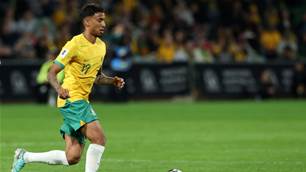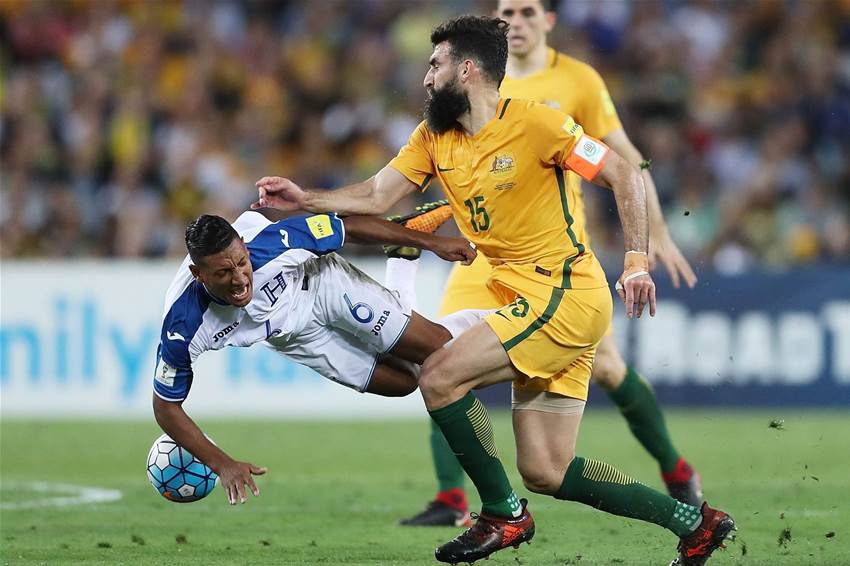After twenty-two matches, two-and-a-half years and one of the most arduous campaigns in football history, Ange Postecoglou’s Australia have qualified for Russia 2018 after seeing off Honduras 3-1 in front of a packed home crowd.
There were many tactical changes throughout the qualification process, but that didn’t stop the team from trying something new in likely the most important match in the Postecoglou era to date.
Heat Map and Average Positions
Statistical analysis of football has exploded in recent years, with a number of new technological advances being accessible to the public. How the data is interpreted however, is a separate issue altogether. Below is a heatmap of the high activity areas of Australia throughout the 90 minutes – for context, the average position of each player can also be seen.
 Australia’s heat map and average positions.
Australia’s heat map and average positions.
It can be seen that Australia, indicated on the map in light blue, maintained the back three formation employed in the away leg, including the diamond formation in midfield. The red area of the map indicates regions of high activity – with this in mind, it can be seen that Australia enjoyed more possession and subsequently more activity on the left, with Aziz Behich in particular being involved in a relatively high amount of play. Central areas in the high defensive third/low middle third are also
especially highlighted, likely due to the sustained build-up play carried out by the Socceroos, who enjoyed approximately 60% of possession, with this number even higher in the first half.
Variable build-up
With Tim Cahill starting the match, it became interesting to see how his inclusion would affect the system. In the past, Cahill has frequently come off the bench and added to the existing set up, but this time his presence seemed to alter Ange’s approach. It was clear that, in the first half especially, the general purpose of Australia’s penetration was to get wide players into crossing positions behind the Honduran defenders, in an effort to capitalise on Cahill’s aerial ability. This process began when Australia had possession in their own half, upon whereupon Mile Jedinak would drop between the centre-backs and provide support to form a back four, as seen below.
 Jedinak dropping into the defensive line to offer support and facilitate direct play.
Jedinak dropping into the defensive line to offer support and facilitate direct play.
There were several potential benefits from this manoeuvre, but akin to any other tactical decision, there is a trade-off. In this case, Jedinak provided extra defensive stability to the team in the event that Australia were to lose the ball playing out, and his position also helped facilitate direct passes over two, three or four lines of pressure. His withdrawn position also created space for his midfield teammates, with less bodies in the same area. This was a strange strategy to watch unfold, as it seemed inconsistent with the vast majority of previous displays under Postecoglou, and hinted towards a pragmatism that perhaps many people had not previously recognised. This was due to the higher number of long passes, the workings of which are illustrated above. When one of the centre-backs had the ball behind Mat Leckie, he checked in towards the ball before turning and accelerating back into the space behind the defence in an attempt to move into a crossing position. Honduras maintained a high line and former Celtic player Izaguirre was able to keep this threat largely under control in the first half. Another trade-off from this tactical decision was the lessening of the tendency to play out through the midfield, with Jedinak no longer behind the first line of pressure to initiate third man runs to break the press. As shown below, the three remaining midfielders positioned themselves directly behind two lines of pressure, meaning that the ability to combine centrally would be somewhat limited, further encouraging direct play.
 Midfield situated behind two lines of pressure and the creation of a 3v1 in high positions.
Midfield situated behind two lines of pressure and the creation of a 3v1 in high positions.
However, due to the aerial ability of Tim Cahill, this often led to 3v1 situations in favour of Australia against the sole holding midfielder of Honduras, allowing for several opportunities towards the end of the opening stanza. However, with only 11 balls into the box from 72% of first half possession, it cannot be said with absolute confidence that this direct strategy paid dividends.
After Australia went 1-0 up via a deflected Mile Jedinak free-kick, Postecoglou withdrew Tim Cahill in favour of Tomi Juric. From this point on, the Socceroos created numerous opportunities in front of goal, and scored two. The introduction of Juric ushered in an on-line change of system; one where possession was maintained through the lines with more regularity, and the diamond midfield playing a very similar role to what it did in the away leg. This included Jedinak returning behind the first line of pressure, encouraging the breaking of the press and progression through central areas. The increase in definition of the diamond midfield led to an increase in middle third combinations, in turn allowing Australia to create more opportunities in and around the opposition goal as a result. Particularly notable was the growth of the dynamic between Mooy and Behich, whose partnership led directly to the awarding of the first penalty and the subsequent second goal.
 Against Cameroon in the Confederations Cup, Leckie and Kruse displayed a similar dynamic to Mooy and Behich.
Against Cameroon in the Confederations Cup, Leckie and Kruse displayed a similar dynamic to Mooy and Behich.
The movement, as outlined above, is one which has been seen repeatedly over the course of the qualifying campaign, but was not as present during the first half of this match. With Behich receiving the ball from a deeper position, Mooy ran across behind the defender into the space ahead of his left-back. As Behich passed the ball up the line, Mooy was able to receive it and drive towards the goal, putting the ball across the ball which led to a handball and eventual penalty. The lead-up to the third goal was not too dissimilar from many goals seen earlier in Ange’s tenure, with the newly brought on Robbie Kruse breaking from deep.
 Robbie Kruse displaying the same movement against Germany, also at the Confederations Cup.
Robbie Kruse displaying the same movement against Germany, also at the Confederations Cup.
As above, it has been a consistent penetration method of Australia to push an attacking midfielder through the lines and behind the defence when the winger has the ball. This movement was more prevalent in earlier editions of the back three when Postecoglou employed a box midfield, but nevertheless is clearly still present in the team’s attacking arsenal. As Kruse is taking from a deeper position, it is less likely that his run will be successfully tracked due to the fact that he is moving into vacant space ahead of the ball, in a region which does not have a specific opposition defender assigned to it. In this sense, he was able to create a dilemma for one of the centre-backs, who had to choose between remaining with Juric or tracking Kruse in a split-second. The defender made his choice, and Kruse went through unopposed before being brought down in the box. Up stepped Mile Jedinak to make it 3-0 and effectively book his country’s spot in next year’s World Cup.
Conclusion
After a qualification period which has lasted over 800 days and spanned three continents, it is finally finished. With a 3-1 win at home, Australia qualified for Russia. Ange Postecoglou has tactically transformed his team in the meantime, evolving constantly to fit the needs of the context. The only question surrounding the team now is whether he will be the man to take them to the World Cup – with the boss remaining tight-lipped on the subject, it is apparent that only time will tell. Congratulations to all involved on a successful campaign and roll on Russia!!!
Nathan Muir is an Australian tactical analyst and coach. You can contact him on Facebook @nathanmuirfootball or on Twitter @NathanKMuir.
Related Articles

Socceroos midfielder embraces move to England

Cardiff City snap up sought-after Socceroos starlet













